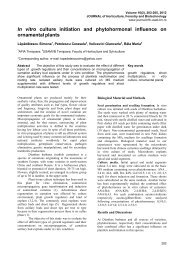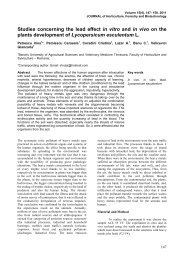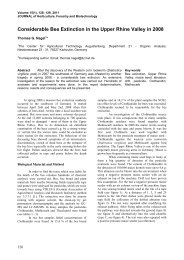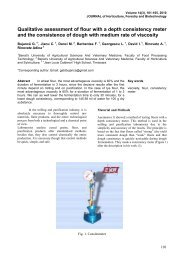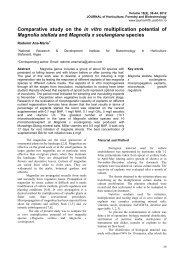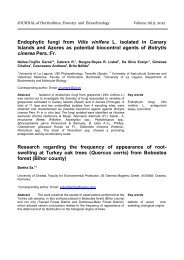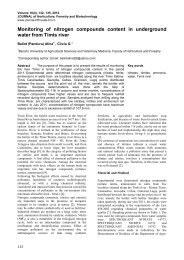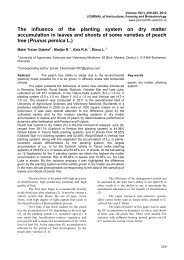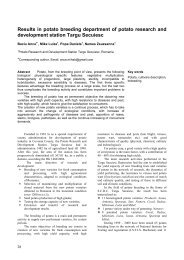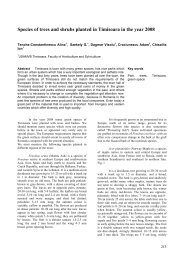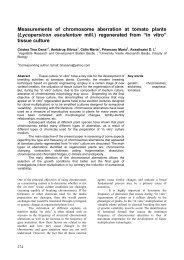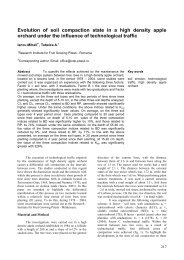Hericium erinaceus and Sarcoscypha coccinea in deciduous forest ...
Hericium erinaceus and Sarcoscypha coccinea in deciduous forest ...
Hericium erinaceus and Sarcoscypha coccinea in deciduous forest ...
Create successful ePaper yourself
Turn your PDF publications into a flip-book with our unique Google optimized e-Paper software.
<strong>Hericium</strong> <strong>er<strong>in</strong>aceus</strong> <strong>and</strong> <strong>Sarcoscypha</strong> <strong>cocc<strong>in</strong>ea</strong> <strong>in</strong> <strong>deciduous</strong><br />
<strong>forest</strong> ecosystem<br />
Fora C.G. 1 *, Lauer K.F. 2 , Ştefan Carol<strong>in</strong>a 1 , Banu C. 1<br />
1 USAMVB Timisoara, Faculty of Horticulture <strong>and</strong> Sylviculture, 2 University of Applied Sciences<br />
Weihenstephan<br />
*Correspond<strong>in</strong>g author. Email: foraciprian@yahoo.com<br />
Abstract Follow<strong>in</strong>g the observation which has been made <strong>in</strong> <strong>forest</strong> st<strong>and</strong>s<br />
from National Park Domogled-Valea Cernei, it has been identify two species<br />
of mushrooms <strong>Hericium</strong> <strong>er<strong>in</strong>aceus</strong> <strong>and</strong> <strong>Sarcoscypha</strong> <strong>cocc<strong>in</strong>ea</strong>. These two<br />
species of mushrooms are specifically <strong>in</strong> <strong>deciduous</strong> <strong>forest</strong> st<strong>and</strong>s.<br />
Mushrooms made part from Fungus Regnum. Are<br />
known <strong>and</strong> described until today 100.000 species <strong>and</strong><br />
8.000 of them are pathogen on plants [1]. Most of them<br />
are saprophytic, with an important role <strong>in</strong> death organic<br />
material decomposition. The parasitic mushrooms live<br />
on tissue alive, be<strong>in</strong>g acidophil organisms [1] <strong>and</strong><br />
produce a lot of plant diseases.<br />
Biological Material <strong>and</strong> Method<br />
To realize the study has been cover <strong>deciduous</strong><br />
<strong>forest</strong> st<strong>and</strong>s <strong>and</strong> made the visual observations on the<br />
health stage of the trees. It has been identify two<br />
species of mushrooms <strong>Hericium</strong> <strong>er<strong>in</strong>aceus</strong> Persoon <strong>and</strong><br />
<strong>Sarcoscypha</strong> <strong>cocc<strong>in</strong>ea</strong> (Scop.) Lamb.<br />
Results <strong>and</strong> Discussions<br />
<strong>Hericium</strong> <strong>er<strong>in</strong>aceus</strong> Persoon (figure 1), is a<br />
rarely mushroom, has the fructification corps made<br />
from a bunch of long spl<strong>in</strong>ter which are fixed on a<br />
fleshy tongue. In some situations it can be found more<br />
corps of fructification which grows together. At the<br />
beg<strong>in</strong>n<strong>in</strong>g the spl<strong>in</strong>ter are white <strong>and</strong> after a period are<br />
brownie. The spl<strong>in</strong>ter can be of 5-6 cm long [2], with<br />
bulk basis of 2 mm.<br />
The breadth of mushroom <strong>in</strong> maturity is of 10-<br />
25 cm [2].<br />
The mushroom corps is white, elastic, with an<br />
<strong>in</strong>significant smell of mushroom. The taste is easily<br />
sweet [2]. The powder of spores is of white color <strong>and</strong> is<br />
such starch. The spores are round, very f<strong>in</strong>e punctuate,<br />
of 5-6 x 4-5.5 µm. It has been found on Fagus<br />
sylvatica, <strong>and</strong> can be found even on Quercus robur,<br />
Malus sp., Betula sp..<br />
It is found from September to October. The<br />
mushrooms has been identify <strong>in</strong> the month November.<br />
In young fazes is comestible, the old exemplars did not<br />
Key words<br />
hericium, sarcoscypha,<br />
<strong>forest</strong><br />
comestible. In Ch<strong>in</strong>a it is used <strong>in</strong> pharmaceutical<br />
<strong>in</strong>dustry.<br />
Figure 1. <strong>Hericium</strong> <strong>er<strong>in</strong>aceus</strong><br />
The genus <strong>Hericium</strong> has <strong>in</strong> central-Europe<br />
zone three species (<strong>Hericium</strong> <strong>er<strong>in</strong>aceus</strong>, Ericium<br />
flagelum on silver, Ericium coraloides). All of them<br />
are parasitic on physiological weakened or wounded<br />
trees but can live saprophytic to on death organic<br />
material. <strong>Hericium</strong> <strong>er<strong>in</strong>aceus</strong> is easy to recognize after<br />
the long spl<strong>in</strong>ter <strong>in</strong> comparison with the other two<br />
species which are short. It can be confused with<br />
Creolophus sciratus which has the spl<strong>in</strong>ter fixed on<br />
evident hat.<br />
<strong>Sarcoscypha</strong> <strong>cocc<strong>in</strong>ea</strong> (Scop.) Lamb. (figure<br />
2), has a form of cup with the diameter of 2-5 cm.<br />
The cup is easily <strong>in</strong>dented. Some parts on<br />
marg<strong>in</strong>s can be observed cracks. The mushroom<br />
growth <strong>in</strong>dividually or <strong>in</strong> throng group. Internal part of<br />
cup is reddish color. The external part is white, covered<br />
with white <strong>and</strong> f<strong>in</strong>e pears. Pedicelum is short of 1-2 cm<br />
long [3], also white.<br />
67
Ascosporous are 26-40 x 10-12 µm, elliptical<br />
<strong>in</strong> shape, smooth, hyal<strong>in</strong>e, <strong>and</strong> have small lipid droplets<br />
concentrated at either end [4].<br />
While <strong>in</strong> most of the Pezizales the entire<br />
ascosporous are formed simultaneously through<br />
delimitation by an <strong>in</strong>ner <strong>and</strong> outer membrane, <strong>in</strong><br />
<strong>Sarcoscypha</strong> <strong>cocc<strong>in</strong>ea</strong> the ascosporous located <strong>in</strong> the<br />
basal parts of the ascus develop faster [5].<br />
The corps of mushroom is th<strong>in</strong>, elastic, by<br />
p<strong>in</strong>k color. Don’t have smell or taste.<br />
This mushroom has found a favorable habitus<br />
<strong>in</strong> thickets of <strong>deciduous</strong> ecosystems, under the shrubs,<br />
more <strong>in</strong> spr<strong>in</strong>gtime but even <strong>in</strong> autumn. The<br />
mushrooms has been identify <strong>in</strong> March.<br />
68<br />
Figure 2. <strong>Sarcoscypha</strong> <strong>cocc<strong>in</strong>ea</strong><br />
It is found on twigs of Prunus sp<strong>in</strong>osa <strong>and</strong><br />
Rubus caesius. Some time grow<strong>in</strong>g under the moss or<br />
ground foliage.<br />
Conclusions<br />
1. Even the wood <strong>in</strong> <strong>forest</strong> ecosystem dies is a<br />
souse of life for different species of<br />
mushrooms.<br />
2. Two species of mushrooms which are found<br />
<strong>in</strong> this habitus are <strong>Hericium</strong> <strong>er<strong>in</strong>aceus</strong><br />
Persoon <strong>and</strong> <strong>Sarcoscypha</strong> <strong>cocc<strong>in</strong>ea</strong> (Scop.)<br />
Lamb..<br />
3. <strong>Hericium</strong> <strong>er<strong>in</strong>aceus</strong> Persoon is rarely.<br />
References<br />
1. Marcu, O., 2005, Fitopatologie <strong>forest</strong>ier ,<br />
Ed. Silvodel, Bra ov, 332<br />
2. Ewald, G., 2006, Pilze, Buchverlag BVL, 640<br />
3. Polese, J.M., 2005, Pilze, T<strong>and</strong>em Verlag, 383<br />
4. Dorothy, B., Thomas R., 1980, Mushrooms of<br />
Western North America (California Natural<br />
History Guides), University of California<br />
Press, 24-25<br />
5. Harr<strong>in</strong>gton, F.A., 1990, <strong>Sarcoscypha</strong> <strong>in</strong> North<br />
America (Pezizales, <strong>Sarcoscypha</strong>ceae),<br />
Mycotaxon 38, 417-458



